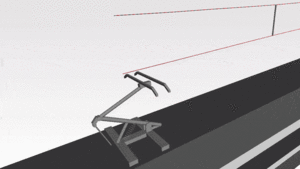Increasing train speeds, higher axle loads, and the demand for improved efficiency and safety require a deeper understanding of the dynamic behavior of rail vehicles and their interaction with the infrastructure. The study of train dynamics enables the development of advanced modeling and control strategies to optimize ride comfort, reduce wear, and ensure reliable operation under varying conditions. By combining numerical simulation, experimental validation, and system analysis, our research aims to enhance the performance and longevity of modern railway systems. Within this framework, current projects focus on active guidance of rail vehicles and the dynamic interaction between pantograph and catenary.

Pantograph–Catenary Interaction
Modern high-speed rail systems require reliable power collection between the pantograph and the overhead line. The pantograph mounted on the vehicle roof must ensure a stable electrical connection even during vertical movements caused by track irregularities or curves. Together, the pantograph and contact wire form a coupled vibration system whose dynamic interaction influences power quality, safety, and wear. For standardized validation, EN 50318 defines procedures that combine measurements and simulations. The simulation will be used for predictive maintenance by analyzing the dynamic behavior and wear of the contact wire and pantograph under realistic operating conditions in order to identify wear patterns at an early stage and plan maintenance measures in a targeted manner based on maintenance requirements.
Duration: 01.11.2025 - ongoing
Contact: DI Rebecca Prattes prattes@tugraz.at

Active guidance of rail vehicles
Higher travelling speeds, increasing axle loads and growing demands on operational safety require new approaches in the track guidance of rail vehicles. Conventional passive systems are reaching their limits, especially when it comes to optimising wear and fatigue on wheels and rails. Active steering systems, which adapt the wheelset guidance to different load and operating conditions, can specifically improve wheel-rail interaction. The aim of this work is to systematically investigate the influence of environmental influences and changes to vehicle and rail parameters on the steering parameters and to develop steering strategies that sustainably reduce wear and fatigue regardless of external influences. This significantly increases the service life of the components and reduces operating costs in the long term.
Duration: 01.09.2023 - ongoing
Contact: DI Lukas Lindbichler lindbichler@tugraz.at
Institute of Mechanics
Kopernikusgasse 24/IV
8010 Graz
Tel.: +43 (0) 316 873 - 7141
ifm@tugraz.at
